
Senecio is a genus of flowering plants in the daisy family (Asteraceae) that includes ragworts and groundsels.
The flora of the Chatham Islands consists of around 388 terrestrial plant species, of which 47 are endemic. The Chatham Islands make up the Chatham floristic province of the Neozeylandic Region of the Antarctic Kingdom.

Olearia lyallii is a New Zealand plant from the genus Olearia. It is commonly known as the subantarctic tree daisy. The species is endemic to the Snares Islands and southern New Zealand, and has also established itself as an introduced species on the Auckland Islands, whence the type specimen was described. O. lyallii forms trees up to 10 m tall with trunks 50 cm in diameter.

Brachyglottis arborescens, the Three Kings rangiora, is a species of flowering plant in the family Asteraceae. It is endemic to New Zealand, where it is known only from the Three Kings Islands.

Brachyglottis is a genus of flowering plants in the family Asteraceae. The genus was erected on November 29, 1775, by Johann Reinhold Forster and Georg Forster. The name was derived from the Greek brachus ("short") and glottis a reference to the size of the ray florets.
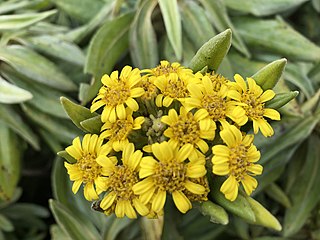
Brachyglottis huntii, commonly called rautini or Chatham Island Christmas tree, is a species of flowering plant in the family Asteraceae. It is found only on the Chatham Islands in New Zealand.
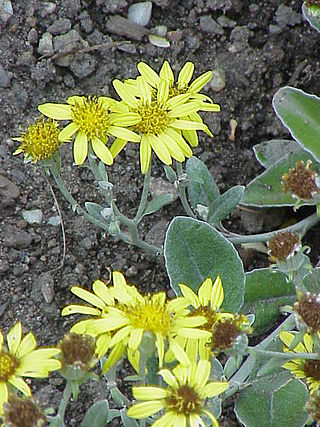
Brachyglottis greyi, commonly known as daisy bush, is a member of the large family Asteraceae and belongs to the genus Brachyglottis or the genus Senecio depending on which authority is being followed. It is an endemic native of New Zealand and lately getting positive attention from gardeners.

The Snares snipe, also known as the Snares Island snipe, or tutukiwi in Māori, is a species of bird in the sandpiper family, Scolopacidae.
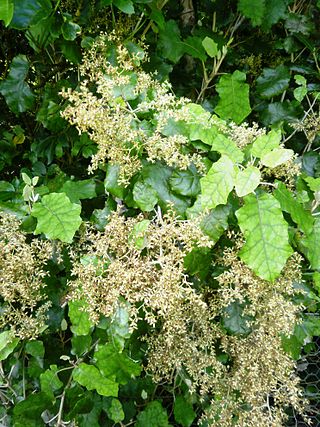
Brachyglottis repanda, the rangiora or bushman's friend, is a small, bushy tree or tall shrub endemic to New Zealand. It grows to a height of 5 to 7 meters. The petioles of the leaves have a characteristic groove up to 10 cm long. The large leaves with a soft furry underside have been referred to as "bushman's toilet paper".
Izatha oleariae is a species of moth in the family Oecophoridae. It is endemic to New Zealand. This species is classified as "At Risk, Naturally Uncommon" by the Department of Conservation. It is only found on the Snares Islands.

Brachyglottis lagopus, commonly called mountain daisy or yellow rock daisy, is a small flowering plant native to New Zealand. B. lagopus is a variable species and can have large and very hairy leaves, and in other regions it has small leaves. Its flowers are yellow.

Brachyglottis monroi is a species of plant in the family Asteraceae, formerly classified in the genus Senecio. Native to New Zealand and Tasmania, it is a small, hardy, evergreen shrub growing to 1 m with crinkly-edged, olive green, leathery leaves and yellow daisy-like flowers in terminal corymbs in summer.
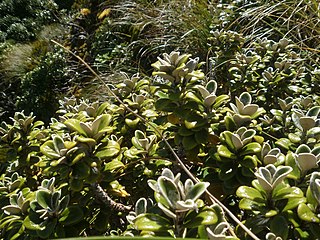
Brachyglottis bidwillii is a species of flowering plant in the family Asteraceae. It is endemic to New Zealand.

Brachyglottis elaeagnifolia is a species of flowering plant in the family Asteraceae. It is endemic to New Zealand, where it is limited to the North Island.

Olearia lacunosa, commonly known as the lancewood tree daisy, is a lowland to sub-alpine shrub or small tree, native to New Zealand. It grows from the lower North Island, southwards along mainly the west coast of the South Island.

Pachystegia is a genus of shrubs in the family Asteraceae, known as Marlborough rock daisies, with distinctive leathery leaves and daisy-like flowers. They are naturally found only in dry areas of the north-eastern South Island of New Zealand.

Jovellana repens is an endemic New Zealand plant in the family Calceolariaceae spread through both the North and South Islands. It has small green leaves and white flowers with spots of purple on the inside.
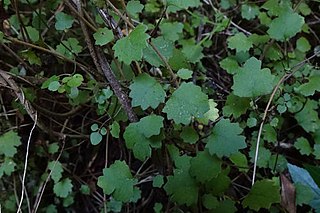
Brachyglottis sciadophila, commonly known as climbing groundsel, is a flowering plant in the family Asteraceae. It has long stems with small green leaves and bright yellow flowers. It is the only climbing daisy which has yellow flowers that is endemic to New Zealand.
















